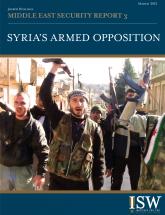Executive Summary
- This report provides detailed information on Syria’s armed opposition movement, highlighting where structure exists within the movement and where Syria’s rebels lack organization. This report does not advocate for or against the policy of arming the Syrian opposition.
- Secretary of Defense Leon Panetta testified before the Senate Armed Services Committee on March 7, 2012 about issues that were restraining the United States from supporting the armed opposition in Syria. “It is not clear what constitutes the Syrian armed opposition – there has been no single unifying military alternative that can be recognized, appointed, or contacted,” he said.
- The armed Syrian opposition is identifiable, organized, and capable, even if it is not unified. The Free Syrian Army (FSA), nominally headquartered in Turkey, thus functions more as an umbrella organization than a traditional military chain of command.
- Three of Syria’s most effective militias maintain direct ties to the Free Syrian Army. They include The Khalid bin Walid Brigade near Homs; the Harmoush Battalion in the northern Jebel al-Zawiya mountains; and the Omari Battalion in the southern Hawran plain, the name used by locals for the agricultural plateau that comprises Syria’s Dera’a province. Appendix 1 lists biographical details of the insurgent leaders affiliated with many effective fighting units. Appendix 2 provides an order of battle for the armed opposition groups by province.
- Other large and capable rebel groups do not maintain such a close relationship with the FSA headquarters in Turkey, but nevertheless refer to themselves as members of the Free Syrian Army.
- Despite the regime’s assault on Homs in February 2012, the insurgency remains capable. The rebels who withdrew from the Baba Amr neighborhood of Homs at the beginning of March 2012 have demonstrated the tactical wherewithal to retreat in order to preserve combat power.
- The Assad regime escalated attacks against the rebels after they defended Zabadani against the Army’s offensive. The affront was probably significant in itself, and the Assad regime could not allow the rebels to hold terrain against the Army. But Zabadani is also vitally important to the regime and to Iran because the city serves as the Iranian Revolutionary Guard Corps – Qods Force logistical hub for supplying Lebanese Hezbollah.
- The Assad regime is likely to continue its strategy of disproportionate force in an attempt to end the uprising as quickly as possible. Indiscriminate artillery fire allows the regime to raise cost of dissent while preserving its increasingly stretched maneuver force.
- The rebels’ resiliency will make the Assad regime’s endurance difficult, but the external support to his regime makes predictions of his imminent fall premature. The Syrian regime has not yet demonstrated the capacity to conduct enough large, simultaneous, or successive operations in multiple urban areas to suppress the insurgency. But it is possible that the technical and material support that Iran and Russia are providing will enable the regime to increase its span of control and its ability to fight insurgents in multiple locales without culminating.
- The rebels will have to rely on external lines of supply to replenish their arms and ammunition if they are to continue eroding the regime’s control.
- The emergence of al-Qaeda-linked terrorist cells working against the regime poses risks to the United States and a challenge to those calling for material support of the armed opposition.
- As the militias continue to face overwhelming regime firepower the likelihood of their radicalization may increase. Moreover, the indigenous rebels may turn to al-Qaeda for high-end weaponry and spectacular tactics as the regime’s escalation leaves the rebels with no proportionate response, as occurred in Iraq in 2005-2006. Developing relations with armed opposition leaders and recognizing specific rebel organizations may help to deter this dangerous trend.
- It is imperative that the United States distinguish between the expatriate political opposition and the armed opposition against the Assad regime on the ground in Syria.
- American objectives in Syria are to hasten the fall of the Assad regime; to contain the regional spillover generated by the ongoing conflict; and to gain influence over the state and armed forces that emerge in Assad’s wake.
- Therefore, the United States must consider developing relations with critical elements of Syria’s armed opposition movement in order to achieve shared objectives, and to manage the consequences should the Assad regime fall or the conflict protract.
Read The Struggle for Syria in 2011.


